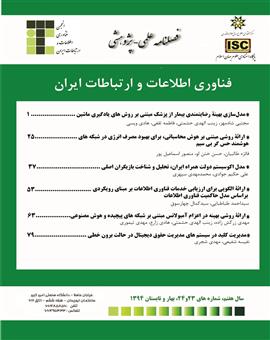مدل اکوسیستم دولت همراه ایران، تحلیل و شناخت بازیگران اصلی
محورهای موضوعی :علی حکیم جوادی 1 , محمدمهدی سپهری 2
1 - .دانشگاه تربیت مدرس
2 - .دانشگاه تربیت مدرس
کلید واژه: دولت همراه, تحلیل اکوسیستم, مدل معادلات ساختاری, بازیگران جدید, خدمات فراتر از انتظار, نوآوری , واسطه ها, تبلیغکنندگان,
چکیده مقاله :
اکوسیستم دولت همراه از اکوسیستمهای در حال شکلگیری در ایران است. هدف این مقاله شناخت و تحلیل ساختار و همچنین شناسایی نقش هر یک از بازیگران اصلی این اکوسیستم است. به منظور نیل به این هدف، ابتدا با استفاده از منابع پژوهش و بررسی مدلهای ارائه شده در این منابع، مدلی مفهومی برای اکوسیستم دولت همراه ارائه میشود که در آن چهار بازیگر جدید: رویکردهای جدید در ارائه خدمات فراتر از انتظار، نوآوری و نوآوران، تبلیغ و تبلیغکنندگان و واسطهها معرفی شدهاند. سپس، با طراحی پرسشنامهای جهت تأیید عوامل شناسایی شده در مدل و بررسی تأثیر آنها بر اکوسیستم دولت همراه، و توزیع آن با بهرهگیری از یک نمونه تصادفی400 تایی، نگرشها و نظرات 363 نفر از خبرگان و کارشناسان حوزه تلفن همراه و دولت همراه جمعآوری و بر پایه مدل معادلات ساختاری تحلیل شده است. نتایج نشان میدهد به جز عامل تبلیغ و تبلیغکنندگان، سه عامل جدید دیگر ضرایب معنیداری در مدل دارند.
The government ecosystem is one of the developing ecosystems in Iran. The purpose of this article is to recognize and analyze the structure and also to identify the role of each of the main actors of this ecosystem. In order to achieve this goal, first, by using research sources and examining the models presented in these sources, a conceptual model for the mobile government ecosystem is presented, in which four new actors: new approaches in providing services beyond expectations, Innovation and innovators, advertising and advertisers and intermediaries have been introduced. Then, by designing a questionnaire to verify the factors identified in the model and examine their impact on the mobile government ecosystem, and distributing it using a random sample of 400, the attitudes and opinions of 363 experts in the field of telephone Companion and companion government have been collected and analyzed based on the structural equation model. The results show that except for the advertising factor and advertisers, three other new factors have significant coefficients in the model.
1. Moore, J.F., (1993), Predators and prey: a new ecology of competition, Harv. Bus. Rev. 71 (3) 75–86.
2. Rong K., Wu J., Shi Y., and Guo L., (2015), Nurturing business ecosystems for growth in a foreign market: Incubating, identifying and integrating stakeholders, Journal of International Management, in press.
3.Battistella, C., Colucci, K., F. De Toni, A. and Nonino, F., (2013), Methodology of business ecosystems network analysis: A case study in Telecom Italia Future Centre, Technological Forecasting & Social Change, Volume 80, Issue 6 , Pages 1194–1210.
4. Iansiti M., Levien, R., (2004), Keystones and dominators: framing operating and technology strategy in a business ecosystem, in: Working Paper #03-061, Harvard Business School.
5. Hearn, G., Pace, C., (2006), Value-creating ecologies: understanding next generation business systems, Foresight 8 (1) 55–65.
6. Peltoniemi, M., (2006), Preliminary theoretical framework for the study of business ecosystems, E: CO 8 (1) 10–19.
7.Hagel, J., Brown, J.S. & Davison, L. (2008), Shaping Strategy in a World Constant Disruption. Harvard Business Review, 80-89.
8.Bluesky Bluesky communications adolfo Montenegro ceo bluesky 478 laufou shopping ctr www.bluesky.as
9. Susan Cable, 2010 Susan cable public technology institute 2010 www.pti.org
10. NTT DOCOMO "sccess in creating mobile contactless payment ecosystem" www.nttdocomo.co.jp.
11. Jennie Carroll "whats in it for me taking m-government to the people"19th bled e-conferenceevalues university of melborne Australia jcarroll@unimelb.edu.ac
12. India ministry of communication and information technology National e-governancedivision department of information technology www.mit.gov.in/whatsnew
13. UEA mGovernement roadmap (2013). Online at:
http://government.ae/documents/10138/84716/mgovroadmapFinaldraft-v1-on+website+30122013.pdf.
14. Kalakota, R., Robinson, M., (2002). M-Business: the race to mobility, McGraw-Hill New York, NY.
15. Hsbollah, H. M., Simon A. and Letch, N., (2012). A network analysis of IT governance practices: a case study of an IT centralisation project, Proceedings of the 23rd Australasian Conference on Information Systems (ACIS).
16. Bailey J. P., and Bakos Y., (1997), an exploratory study of the emerging role of electronic intermediaries, International Journal of Electronic Commerce: 7-20.
17. Lyer, B., et al. (2006). "managing in a small world ecosystem: some lesson from the software sector" Californial management review 48 (3): 28-47
18.Porter, M.E. (1980) Competitive Strategy, Free Press, New York, 1980. The book was voted the ninth most influential management book of the 20th century in a poll of the Fellows of the Academy of Management
19.Mark Hoelzel (2015). Mobile advertising is exploding and will grow much faster than all other digital ad categories, www.businessinsider.com
20.AL- Sobhi, F, Kamal, M, Weerakkody, V (2009). Current state of e-services in Saudi Arabia: the case of intermediaries in facilitating government services in Madinah city
21.Janseen, M, & Klievink, B (2009). "The role of intermediaries in the muulti- channel services delivery strategies" international Journal of electronic government research 5, 36-46
22.Dombrowski, A. Voida. G.R.Hayes and M.Mazmanian, 2012 E-government intermediaries and challenges of access and trust university of California, Irvain
23.Emmanuel Bertin, Noel Crespi, Michel L Hostis (2013) "A few myths about Telco and OTT models" Orange labs-42, rue des coutures 14066 Caen France


